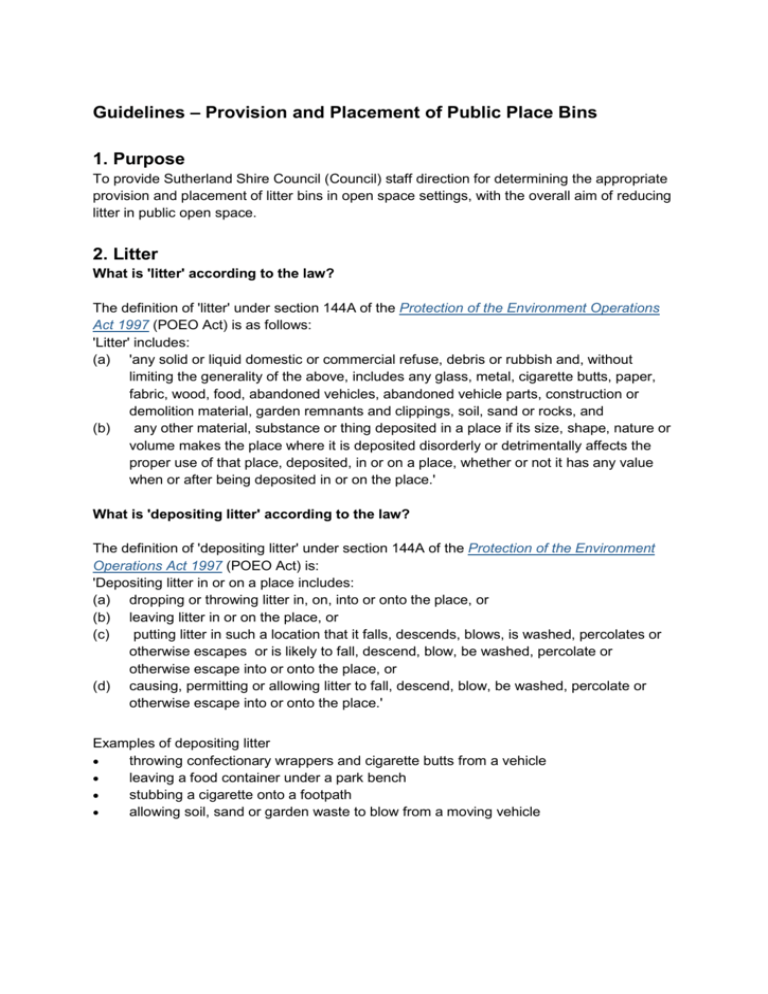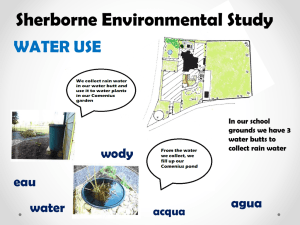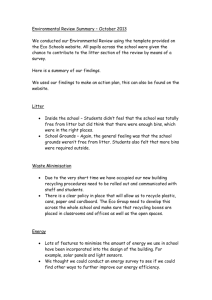Guideline Provision and Placement of Public Place bins
advertisement

Guidelines – Provision and Placement of Public Place Bins 1. Purpose To provide Sutherland Shire Council (Council) staff direction for determining the appropriate provision and placement of litter bins in open space settings, with the overall aim of reducing litter in public open space. 2. Litter What is 'litter' according to the law? The definition of 'litter' under section 144A of the Protection of the Environment Operations Act 1997 (POEO Act) is as follows: 'Litter' includes: (a) 'any solid or liquid domestic or commercial refuse, debris or rubbish and, without limiting the generality of the above, includes any glass, metal, cigarette butts, paper, fabric, wood, food, abandoned vehicles, abandoned vehicle parts, construction or demolition material, garden remnants and clippings, soil, sand or rocks, and (b) any other material, substance or thing deposited in a place if its size, shape, nature or volume makes the place where it is deposited disorderly or detrimentally affects the proper use of that place, deposited, in or on a place, whether or not it has any value when or after being deposited in or on the place.' What is 'depositing litter' according to the law? The definition of 'depositing litter' under section 144A of the Protection of the Environment Operations Act 1997 (POEO Act) is: 'Depositing litter in or on a place includes: (a) dropping or throwing litter in, on, into or onto the place, or (b) leaving litter in or on the place, or (c) putting litter in such a location that it falls, descends, blows, is washed, percolates or otherwise escapes or is likely to fall, descend, blow, be washed, percolate or otherwise escape into or onto the place, or (d) causing, permitting or allowing litter to fall, descend, blow, be washed, percolate or otherwise escape into or onto the place.' Examples of depositing litter throwing confectionary wrappers and cigarette butts from a vehicle leaving a food container under a park bench stubbing a cigarette onto a footpath allowing soil, sand or garden waste to blow from a moving vehicle 3. Sutherland Shire Council’s Approach to Litter 3.1 Education Community education and awareness is a key to influencing littering behaviours. Council’s Waste Services Unit undertakes the following responsibility with regards to litter: Coordination of the Local Waste Management Plan (LWMP) Development of education programs including communication campaigns Grant submissions to address litter issues and the administering of any successful grant applications. 3.2 Enforcement Council’s Environment Protection Officers undertake enforcement measures in accordance with Local Government Act 1993 and the State Government’s POEO Act 1997. This includes illegally dumped residential or commercial waste. 3.3 Maintenance Programs Council undertakes an extensive range of maintenance activities in an endeavour to keep public areas litter free. These programs are designed to: Maintain a visually pleasing and acceptable public amenity Maintain public health Enhance the positive and safe image of the Shire, in support of Council’s corporate vision Protect our drains and waterways from the intrusion of litter Discourage littering behaviours, including illegal dumping These programs include: Litter patrols Servicing public litter bins (emptying, cleaning, repairs & maintenance) Street & footpath sweeping Footpath stain removal/cleansing Hard Waste Collection Service Chemical collection program Storm water (pit & pipe) inspection & cleaning program 3.4 Infrastructure Litter bins are installed by Council at a variety of locations and settings throughout the Shire in public open space areas. These bins are provided for use by the general public in order to enable the legal disposal of litter. They are not to be used for the disposal of residential or commercial waste. 4. Where is Litter Generated in Sutherland Shire? Litter can be generated anywhere people congregate: Public Buildings Railway Stations and high use Bus Stops. Litter from residential collections Parks, sporting grounds and boat ramps Shopping Centres / Shops (particularly those where fast food is served) Roadside litter from passing traffic Overflowing Kerbside Domestic Bins Construction sites Illegal dumping on roadways and reserves 5. What Prompts Consideration for Installation of Public Litter Bins? Council targets its actions for specific sites considerate of: Litter observations Litter impacts on operational / maintenance activities Community feedback Sites of significance Highly visible or high visitation areas Presence of infrastructure eg, Playgrounds, BBQ, Environmental impacts 6. What Factors Are Considered When Selecting A Bin? Council will manage bins following recommended best practice for reducing littering in public places as summarised below and customized to our particular needs. [Source: Curnow et al. (2002); VSC (1999); Reeve et al. (2000) summarised reviews by Huffman et al. (1995) and BIEC (1997a).] Placing litter and recycling bins in locations that are convenient / accessible to the public (i.e. located close to the source of litter, such as fast food outlets, ATMs and exits from large public venues). Undertaking site assessments to identify those bins that are the most heavily used particularly near stormwater management systems and water bodies. These bins should be subject to increased levels of inspection (and if necessary, maintenance). Designing bins that catch the attention of the public and are easily identifiable. Bins are to complement, not dominate or detract from, open space area. The WH&S risk exposure to waste collectors is to be minimized wherever possible. For this reason, wheelie bins are to be adopted as the primary bin type Consistent Style Enables public litter bins to be easily recognized. Stock management is made easier. Economies of scale are delivered for purchasing. When designing bins, the bin opening should be small enough to discourage illegal dumping, yet acceptable for standard litter items. Cigarette butt litter is acknowledged as one of the most common forms of littering. For this reason cigarette butt disposal units are to be incorporated into public litter bins. Bins are to have closed tops to prevent disturbance of rubbish by animals and the intrusion of rain water. Decisions made regarding the size of bins should seek to minimise the required emptying frequency while discouraging illegal dumping. Assessing the need for specialist bins in specific locations (e.g. for cigarette butts, sharps, etc). Placements of politely worded signage close to where littering occurs Keeping observable litter to a minimum (e.g. through frequent collections) as littering rates are reduced in areas that are regularly cleaned: ‘clean equals clean’. Typically, bins should be emptied before they reach 75 - 80% full. The service provider that undertakes bin emptying should be responsible for clearing up unconfined litter within a specified radius of the bin (e.g. two metres). The frequency of bin emptying will vary depending on the location, however a general guide in urbanised areas is that: Street litter bins will need emptying at least daily; and Park litter bins will need emptying at least weekly. Some sites will have seasonal variations eg beachfronts or be event specific. Involving the community in litter management initiatives (e.g. involving users of public areas in the design and placement of bin facilities). Acting on behaviour (e.g. with rewards and/or sanctions, as appropriate). Encouraging responsibility such as “carry in – carry out” policy for walking areas of reserves and parks (e.g. behaviour change programs to encourage people to take responsibility for carried litter and dog droppings). Designing public open space to minimise areas that are hidden from public view. Integrating programs (e.g. anti-littering educational strategies should be accompanied by the provision of litter bin and recycling infrastructure and sound maintenance regimes). Demonstrating commitment (e.g. agencies promoting anti-litter messages must lead by example). Public Recycle Bins For public recycling bins to be successful greater diligence is required by users in ensuring that only ‘recyclables’ are deposited in the designated bin. Council’s experience to date has shown that generally the amount of non-recycables (contamination) deposited is above an acceptable fresh-hold, leading to the product being rejected and sent to landfill. Council is yet to consider a formal post implementation review of recycling bins at several trial sites. Without seeking to influence any decision in relation to the provision of recycling bins in public spaces, the following expert advice [Quinn (1999)] has been included: In relation to recycling bins the following key elements must exist for recycling to work in public places: The bins should be labelled using appropriate symbols and a recognisable and consistent system of colours. Bins should be grouped into stations with a litter bin at either end and recycling bins in the middle. Bins should only be provided for items which patrons easily identify with recycling. Recycling bins should have locked lids and holes in the lids the size and shape of the materials to be put in them. Litter bins should have the lids open. Bins should have overhead signs so that their location can be seen above a crowd. 7. Method of Council Assessing the Provision of Public Litter Bins in Public Places 7.1 Determining Bin Locations The following assessment will be made when determining the requirement for a litter bin: Is there a litter problem? What is the extent of the litter problem? Volume Regularity Who is the source of the litter? Pedestrians Road users Rubbish dumpers Environment and location (wind, water , passing vehicles) Animals (dogs if so responsibility of owners) What is the usage level or public exposure to the site? Congregation levels (reference respective asset hierarchies) Prominence Is there a litter generating source or activity in the immediate area? e.g. shop, bus stop, BBQ area, playground Will a bin be a cost effective measure to address the litter problem, include expected frequency of emptying? Sites may need more than one evaluation if there is confusion with the alleged issue and what is found on site. Site visit with requestor may be required. 7.2 Location Bin Quantities New Bin Locations Bin quantities at individual locations will be determined by anticipated litter volumes for all new sites based on provision of bins at like sites and in accordance with adopted Council service standards Existing Bin Locations Bin numbers will be adjusted up or down at locations based on: Litter counts Bin utilization rates Cost analysis of bin installation versus bin emptying frequencies Bin sizes options Degree of illegal dumping Proximity to litter source 7.3 Bin Installation The specific installation of a bin will consider: Littering observations People movement / travel node Proximity to the littering source Site location / site use contributory impact Impact on the immediate amenity Access and maintenance As this system is currently under trial, a benchmark score has yet to be adopted that will confirm that a bin is to be installed. In the interim a score of 20 is regarded as the freshhold to warrant installation of a bin. BIN INSTALLATION EVALUATION FORM Location Officer Name Time Evaluation Date CRITERIA WEIGHTING SCORE COMMENTS Is there a Litter problem? Yes = 2 No = 0 What is the extent of the Litter problem? Severe = 5 Moderate = 3 Minor = 1 Non Existent = 0 Who is the source of the Litter? Pedestrian = 3 Congregation Point = 3 Car/ vehicle = 1 Rubbish Dumper = 0 Should others deal with the litter? If Yes, (immediate fail) What is the usage level/ public exposure of the site? High = 5 Moderate = 3 Minor = 1 Non Existent = 0 Is there a litter generating source/ activity nearby? Immediate Area = 10 Eg, takeaway shop, ATM, Within 50 metres = 1 Within 20 metres = 5 >50 metres = 0 Is there a BBQ/ picnic tables onsite Yes = 3 No = 0 Will a bin be a cost effective measure to address the litter issue? Significant = 5 Moderate = 3 Minor = 1 Non Existent = 0 Do existing bins provide sufficient coverage? If Yes, (immediate fail) If No = 3 Will bin servicing present an unacceptable WHS If Yes, (immediate fail) risk? TOTAL SCORE 7.4 Prioritising Although the need for a bin(s) may be established, financial constraints may influence the installation and emptying of litter bins. The following methodology is to be used to prioritize the installation of public litter bins: 1. 2. 3. 4. 5. Public health & safety Quantity of litter in area Cultural/ Tourism significance of the site Aesthetic impact in local areas Use of the site e.g. used for regular sporting activities versus unused reserve. Each of the criteria is weighted to reflect Council priorities. As this system is under trial, initially a score of 20 or more will be required for a bin, evaluated as required, to be installed. BIN PRIORITISATION ASSESSMENT FORM Criteria Public Quantity of Health and Litter Safety Weighting High = 10 High = 4 Medium = 5 Medium = 3 Low = 2 Low = 1 Eg. CBD 10 4 Cultural/ Tourism Aesthetic Impact User numbers High = 4 Insignificant =1 High = 10 Medium = 2 Low = 1 High = 3 Medium = 2 Low = 1 4 10 3 Total Score 31




